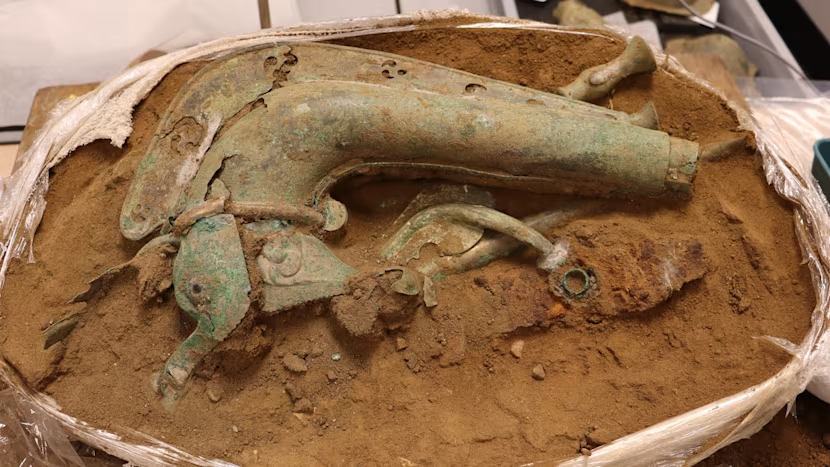On March 12, 2023, hydraulic shovel operator Jenna Plamondon noticed fossilized plesiosaur remnants at the Mildred Lake site thanks to a bird's-eye view from the cab of her machine.
Suncor Energy, Tuesday, May 2, 2023, Press release picture
Although this marine reptile's fossils have previously been discovered in the area, this find represents the earliest Cretaceous plesiosaur to be discovered in Alberta.
At the Syncrude Mildred Lake Mine, Jenna was working her first day shift since her return when she noticed a disparity in the oil sand.
"I continued looking at one tiny dirt particle. We are taught to notice things that are unusual as shovel operators. Our pit and keeping the area tidy are really important to us", says Jenna, a 16-year employee. "I called my leader and requested them to confirm with geology. In case it was a genuine fossil, we decided to move the shovel."
The Mildred Lake Geology team came and immediately realized what they were seeing was unique. To ensure that the fossil could be recognized and saved as a piece of Alberta's history, they got in touch with the Royal Tyrrell Museum of Paleontology. It was discovered after further investigation that the intact fossil jutting out of the ore was a fragment of a plesiosaur tail.
Older than dirt
Around 115 million years ago, when the mining region would have been a part of a large, shallow sea that encompassed much of northern Alberta, these aquatic reptiles existed. The layer of bitumen-rich ore that the fossil was found in added to the find's rarity. In contrast to the usual location higher up in the rock strata, this instance was located lower down in the McMurray Formation layer.
The fossil and the site of its discovery provide an intriguing glimpse into the past. The extinct marine reptile might have perished in an inland sea and washed up into shallow water as a carcass for other predators, like dinosaurs, to scavenge.
This one might have been covered in sand after a storm that dumped a lot of sand on top of the carcass all at once. The preservation circumstances shown by this are quite exceptional, according to Dr. Donald Henderson, the museum's curator of dinosaurs. Fossils of large creatures like dinosaurs and marine reptiles are extremely uncommon. We are only fortunate to observe this small fragment of fossil since we are shifting so much rock here.
Mine Operations gathered and arranged nearby oil sand into rows in order to search for fossil fragments that might have broken off from the larger piece. The field technicians for paleontology and geology then went through the information. One little piece of a vertebrae was found by a geology co-op student after several hours of searching.
Ruachwaar Gatwech, a third-year geology student at the University of British Columbia, says, "As we were digging, I found something that looked like bone, but I thought it could be something else." "The senior geologist thought that taking me and another co-op student to the site would be a worthwhile learning opportunity. A memorable experience it was. My first experience in the mine and my first encounter with an authentic fossil on the field.
The fossil was prepared for transport back to the museum in Drumheller, roughly 650 kilometers south of Fort McMurray, by the museum's paleontology staff in a manner akin to that of a cast made from human bone. With this method, the plaster can be fitted closely to the fossil without coming into contact with the bone. The delicate bone is safeguarded so that it can be taken to the museum for more in-depth analysis.
Jenna is pleased with the part her shovel crew performed in preserving a piece of history.
"I'm really excited because if the fossil ends up being displayed at the museum, I'll get to show my one-year-old son what mom found," the woman exclaims. "It's pretty cool that I'm one of the few shovel operators to find one," one said.
More than a dozen fossils have been identified since the first one was found at a Syncrude site in 1994. Other Suncor locations have had a number of ancient discoveries, including the 2011 finding of Base Plant, where a nodosaur, Alberta's oldest dinosaur, was found.







